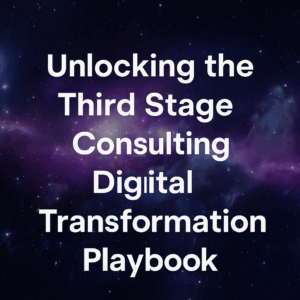There are three stages to digital transformations, with the third stage being the most successful phase and the most important phase of digital transformation. Believe it or not, most organizations fail to reach that third stage of success. In this blog, I’m going to give you the secret sauce to what you can do differently to make sure your digital transformation reaches the third stage of success.
To set the stage, when we first started and named the company Third Stage, it was named after a rocket launch analogy. When rockets are launched historically, there are two stages or two boosters that got the rocket up into space. It is the third stage launch from those boosters from the two boosters that would get it up into its ultimate heightened speed and up into orbit. This is a big part of why the company is named Third Stage.
I felt like that was a good analogy for digital transformations because many digital transformations fail to reach that third stage, they fail to get off the ground, they fail to fight gravity, and they have that inertia that they have trouble getting past.
We really like this analogy as a way to talk about how digital transformations go and what some of the challenges are that organizations face. Here are some questions we will cover today:
- Why is it that most organizations fail to reach that third stage of success?
- What are the ones that do reach that third stage?
- What are they doing differently?
- What can you be doing differently to reach that third stage of success?

Table of Contents
ToggleBusiness Process Alignment
When we look at companies that are successful, and that have reached that third stage of success, one of the biggest things they do well and better than their counterparts that don’t reach that third stage is they do business process alignment well. They don’t simply defer to the technology and assume that the technology is going to solve their business problems for them, but they define know how they want to solve the business problems and what they want their operations to look like.
For example, a lot of times what happens in organizations is that they will choose a new technology. The software vendor or the sales reps will convince the organization that they don’t need to worry about their business processes because their new technology has best practices in it or industry best practices. Therefore, they will come in with the answers of how the business process should look.
Now, that may be true at the granular level of how transactions work within a software system, but that’s not true at the high level of how you want your business to function. That’s one problem with that philosophy. The other problem with that same flawed approach that software vendors typically perpetuate, is that today’s technology is very flexible and can handle a plethora of different workflows and business processes and different options within the system.

In the end, to assume that somehow the software vendor or the software solution itself is going to answer the question of how to run your business for you, it’s simply not true, you need to have a clear vision of what you want your business processes to look like. Now, it’s not only an upfront decision that needs to happen well in determining business process alignment. But we also need to make sure that as we’re implementing technology, and ultimately going live with the new technology that we figured out and determine how that technology is going to be embedded within our business processes.
It’s one thing to get the technology to work and to do what you want it to do. But, it’s a very different thing now to figure out how to embed that within your day-to-day operations. We find that a lot of times organizations will implement new technology, but the people don’t use it, and if the people aren’t using it, the business processes aren’t fully in sync with those new technologies.
Overall, it doesn’t matter that the technology works, because it’s really not working, it’s not working for your business. Organizations that reached that third stage of success, know how to handle business process alignment very well.
Organizational Change Management
One of the biggest things holding companies back from reaching that third stage of success is organizational change management or lack thereof. Most organizations are so focused on the technology, but they’re rarely focused enough on the organizational change management or the people side of the equation. Organizations that are successful, focus on the people side.
What is important is that we have to look at what they do well, and what they do differently. What they do differently is, for example, organizational design. They define what people’s roles and responsibilities are going to look like in the future, they take the time to define that future state organization.
More importantly, they take the time to start rolling out those changes to the organization before they get to go live training and the end of project type of communications that most people think of when they think of change management. There’s a lot of upfront strategic work that needs to happen to ensure that the training communication stuff later in the project are going to be successful.

Another example of something that needs to happen early that most organizations overlook is an organizational assessment and understanding culture. What the potential pocket of resistance are going to be which every organization faces resistance, whether you know it now or not, your organization will face resistance to any sort of changes you might want to roll out. The key is assessing your organization and your situation so that we can define a change strategy.
Organizations that are successful and effectively handle organizational change management are the ones that are more likely to succeed. Now for more information on organizational change management, check out this guide for how to manage all things organizational change. It’s perfect for anyone going through an organizational change project or a digital transformation of any sort.
Business and Technology Intergrations
Another differentiator for organizations that reach that third stage of success is business and technology integration. In other words, not just implementing technology and business process changes and isolation from one another, but looking at the entire big picture of how this is all going to fit together.
Here is a list of questions that you should consider during your integration process:
- How will our business processes flow?
- What will those handoffs between processes or different parts of our organization what will that look like?
- With technology, how does our technology interact with one another?
- How are we going to tie this all together?
- How is data going to flow?
- What’s the single source of truth going to be?
- Where’s that data going to reside?
- How are we going to manage the master data longer term?
All these questions are things that aren’t necessarily critical to implementing technology per se, but they are critical to getting the full business value out of your digital transformation. That’s one of the things that companies that reach the third stage of success do well is they get the ROI and the business value that they expect out of their digital transformations.

Data and Security
Another common afterthought that’s a big mistake in digital transformations, is data and security. The technology might be in place and the technology is working, you’ve even tested it, but even if you’ve aligned it with your business processes, you manage change well, but it can all fail if you don’t have a solid focus on data and security. What we mean by this is a couple of things:
- You want to make sure that the data you’re bringing over to the new technology is clean, that it’s the right data that you’ve cleaned it up that you’ve mapped it to the new system appropriately.
- Ensure that we have Master Data Management processes in place to ensure that once we have the data brought over and we’ve cleaned it up, we’ve mapped it over to the new system so that we’re not corrupting the data because people aren’t tracking the data or maintaining the data the way they should.
We want to be able to set up a master data management processes that enable data to remain clean, even after implementation. The final part of this is the whole security aspect of things. How do we ensure that we don’t just hacker-proof our systems ensure that people can’t hack into the system, but just as importantly, maybe, more importantly, is make sure that we tightened up the security within the new technologies so that people internally are only accessing what they should be accessing.
In the end, we want to do that via security profiles and different security mechanisms within technology to ensure that we avoid that common security problem.
Testing
Testing is another common problem with transformations. Now, most organizations know that they need to test most organizations don’t simply skip over the testing process, but the way they do it is significantly flawed. Typically testing is more focused on ensuring that the technology works from a technology perspective. In other words, making sure we worked out all the bugs and that the technology is sound, but that’s not nearly as important as making sure that the technology works for our business.
The user acceptance testing, or the conference room pilots is what I’m talking about here. It is really important to make sure that we’ve worked through all the different scenarios and the major exceptions that we might see in our day-to-day operations and ensuring that we’ve worked through it all because not only it’s important to ensure that we’ve defined our processes and our technologies clearly, but also to make sure that people internally within the company understand how those new processes are going to work.
This can be very helpful from not just a testing perspective, but also from a change management communications perspective as well. Overall, it is important to make sure that you have a very robust testing process. When you’re looking at your vendor-proposed testing plan, you want to make sure that you’ve added some buffer to that to account for your own user acceptance testing, in addition to the technology testing that they might be doing.
Benefits Realization
Finally, when we look at what companies that reached the third stage are doing differently to fully realize the value of their investments in technology, is benefits realization. Benefits realization in its simplest terms is really a way to define what it is you expect to get out of your new system, and then actually going to measure the actual results after you’ve gone live with the new technology or technologies. This is an area that so many companies overlook and don’t even think about doing.
The value of doing what I’m suggesting here is that the level of effort and cost to do this is so minimal when compared to the overall time and cost and effort that’s gone into the technology implementation. The value you get out of it is so massive and so, it’s important to do this.

One of the problems people run into is that they’re afraid to go back and look at what results are we actually achieving, because chances are, quite frankly, you’re not going to have achieved the benefits you expected right away. That’s the whole point of going through a benefits realization exercise to ensure that we look at where we’re achieving our benefits and where we’re not achieving our benefits.
It’s things like not training the group on how to use this certain function within the system, which undermines the business benefits. Think about that for a minute and the level of effort that would take versus the amount of effort it just took to go through the entire transformation. It’s pretty minimal, but the amount of impact it has on positive ROI is huge. We have a lot of lessons from organizations that have gone through this benefits realization process.
Key Takeaways
These are just some of the things that we commonly see organizations do wrong, that undermine their ability to reach that third stage of success. In addition to the things, we’ve talked about here, there’s also things that you could be doing from a quality assurance perspective. Having a solid project management and quality assurance framework in place can be one of the best ways to address the things we’ve talked about in this blog, but also uncover other risks that we haven’t talked about in this discussion as well.
I hope you found this information useful and if you have any questions or would like to brainstorm ideas related to elevating your digital transformation to the next level, please reach out to me directly. I’m always happy to be an informal sounding board for you and your team.






